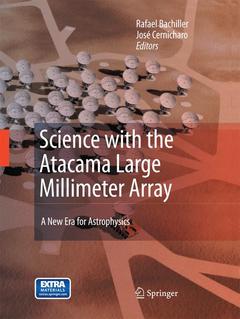Description
Science with the Atacama Large Millimeter Array:, 2008
A New Era for Astrophysics
Coordinators: Bachiller Rafael, Cernicharo Quintanilla José
Language: English
Subjects for Science with the Atacama Large Millimeter Array::
Keywords
ALMA; Astrophysics; Cosmology; Evolution; Galaxies; Radioastronomy; Redshift; Star Formation; Universe; molecule; spectra
Publication date: 11-2014
335 p. · 21x27.9 cm · Paperback
Publication date: 05-2008
335 p. · 21x27.9 cm · Hardback
Description
/li>Contents
/li>Biography
/li>Comment
/li>
Currently under construction in Northern Chile, the Atacama Large Millimeter Array (ALMA) is the most ambitious astronomy facility under construction. This book describes the enormous capabilities of ALMA, the state of the project, and most notably the scientific prospects of such a unique facility. The book includes reviews and recent results on most hot topics of modern astronomy. It looks forward to the revolutionary results that are likely to be obtained with ALMA.
Rafael Bachiller is the director of the Spanish Observatorio Astronómico Nacional (OAN). He received his doctorate in physics at the University Joseph Fourier (Grenoble, France). His research interests include the molecular content of planetary nebulae and the processes of star formation with special emphasis in the bipolar molecular outflows and their chemistry.
José Cernicharo is a research professor at the Spanish Consejo Superior of Investigaciones CientÃficas. He received his doctorate in physics at the University of Paris IX. He is project scientist of the Herschel Space Observatory. His research interests cover most aspects of molecular astrophysics (identification of interstellar molecular species, physics and chemistry of the interstellar and circumstellar media, study of water vapour in space, etc).
Both are world-wide recognized specialists in millimeter/submillimeter astronomy and have been involved in ALMA from the genesis of the project to the more recent participation in the advisory and governing bodies (namely in the Scientific Advisory Committees and the ALMA Boards).
Describes the enormous capabilities of the Atacama Large Millimeter Array (ALMA), the state of the project, and most notably the scientific prospects with such a unique facility
Provides the science case for ALMA, the most ambitious telescope in construction of present-day Astronomy
Covers most hot topics of modern Astronomy (from the Solar System to high-z galaxies, with important articles on molecular clouds, star and planet formation, etc.) with prospects to the revolutionary results to be obtained with ALMA
Contains recent results on millimeter and sub-millimeter astronomy presented by the most reputed scientists in the field




